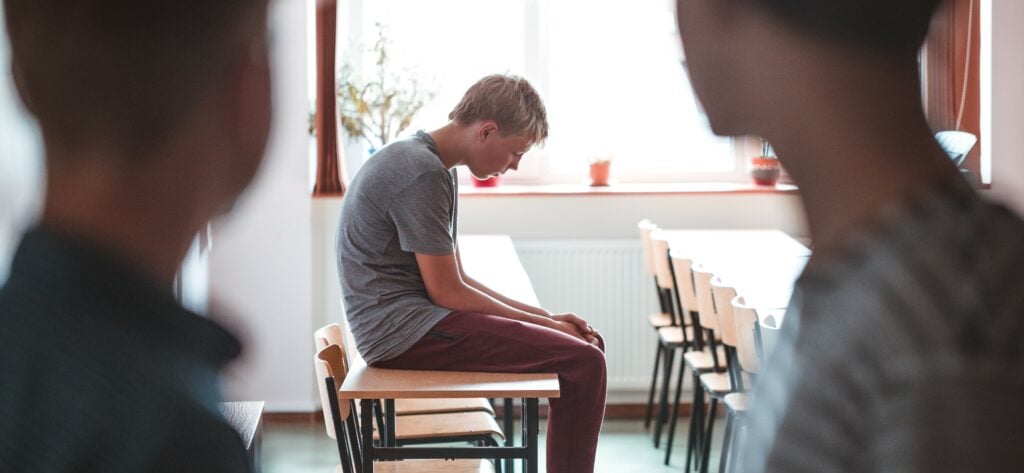Trauma from bullying and cyberbullying
Reviewed by Robert Bogenberger, PhD


For Gen Xers, bullying was a fact of life—and for a sensitive, overweight kid like me, high school was a nightmare. Not a day went by when there wasn’t some act of aggression in the halls.


By the time I became a parent and my own kids began high school, it seemed like we’d learned and corrected so much as a society. Gone were the days of daily fistfights and nasty messages on bathroom walls. But the more I talk to my teens and my other parent friends, the more I realize bullying hasn’t stopped—it’s just evolved. Today’s schools are petri dishes for more subtle, insidious threats like cyberbullying and verbal harassment.
Bullying is also more dangerous than ever because it’s no longer confined to school. A bully can reach our children where they live and where they play, and it may not even be someone they know. That’s why it’s essential for parents to understand how the trauma of bullying shows up, and how to help our kids work through it.
What is bullying, and how often does it happen?
According to the American Psychological Association (APA), bullying is a form of aggressive behavior in which someone intentionally and repeatedly causes another person injury or discomfort.1 Bullying takes various forms, including verbal, physical, social, and cyber. It can happen to anyone, but LGBTQIA+ youth tend to be at higher risk.2 Bullying takes place at school, at home, online, or in the community, which makes it hard to avoid.
Is bullying on the rise?
Bullying may look different now than it did 30 years ago, but it still happens far too often. Psychologist Janine Oliver, PhD, MSW, LCSW, whose research includes bullying and social media, explains that today’s numbers are higher in part because we’re paying more attention. “People care about the effects of bullying now because we’re discovering the link to depression and suicide among young people,” she says. When you consider types like cyberbullying and sibling bullying, the danger seems even more prevalent.
The Centers for Disease Control and Prevention (CDC) says that reports of bullying are highest in middle schools (28%), followed by high schools (16%), combined schools (12%), and primary schools (9%).3 But experts believe these numbers may not reflect the full scope of the issue because many cases go unreported due to fear, shame, or lack of awareness. These numbers may also exclude sibling bullying or other forms of the behavior that aren’t as widely recognized.
If you’re in crisis or know someone who is, help is available now: Call or text the free, confidential 988 Crisis Lifeline at 988 anytime.
Bullying and the brain
Not only does bullying create mental health challenges for victims, but it can also change the way our brains work.4 Bullying can actually alter brain chemistry, especially for children in grade school. “The younger you are, the greater the impact, because your brain is still forming,” Oliver says.
The main culprit is stress. Prolonged exposure to traumatic stress affects the amygdala, hippocampus, and prefrontal cortex, and it can trigger hyperarousal, similar to a posttraumatic stress disorder (PTSD) response.5 In a landmark study using rats, researchers concluded that victims of bullying may be more prone to drug use because of their altered brain chemistry.6
Sibling bullying
It’s scary enough when school doesn’t feel safe—things are even more challenging for the 50% of kids who experience bullying at home by a sibling.7 Sibling bullying looks similar to bullying by people outside the family, Oliver says: “There are the same behaviors: manipulation, intimidation, and there might even be sabotage.” But because this aggression is happening at home, it’s often dismissed as a natural part of growing up with siblings.
The damage can be serious, though. Research shows that people who’ve been bullied by a sibling are approximately twice as likely to experience anxiety, depression, or thoughts of self-harm.8 Victims of sibling bullying are also more vulnerable to peer bullying.9
What to watch for
Sibling bullying may be harder to see because it looks so much like age-appropriate conflict among children. Here are a few indicators parents should watch out for:
- Patterns of manipulation or aggression coming mostly from one sibling
- No conflict resolution
- An obvious power imbalance
- Contempt from one sibling for another
How to respond
If you see any of these behaviors in your home, contact a mental health professional for support. Individual therapy for the victim or family therapy for all of you are both ways to help navigate this challenge. A therapist can also offer guidance on self-regulation, conflict resolution, and other techniques for your family to use at home. To find a licensed provider near you, visit our directory.
Cyberbullying
As technology has become ever more pervasive, the opportunities for bullying have increased. The CDC reports that cyberbullying is highest in middle schools (33%), followed by high schools (30%), combined schools (20%), and primary schools (5%).10 The most common forms of cyberbullying are verbal harassment, slander, mocking, and threats. Groups also bully by excluding and harassing specific kids.
What to watch for
Because many kids spend a lot of time on their phones, it may be hard to tell when they’re being harassed or bullied. Oliver says there are a few behaviors to pay attention to:
- Stress in relationship to their phone
- An obvious change in usage
- Shift in mood around phone use
How to respond
Cyberbullying is still a newly regulated form of bullying, and most incidents go unreported. Some types of incidents—for example, threats of violence or sexually explicit messages—should be reported to local law enforcement, as there are laws in place to protect victims. Resources at stopbullying.gov can help walk you through the reporting process.11
For grade schoolers and middle schoolers, parental controls can be very effective at monitoring which sites kids visit and who they’re communicating with. Here’s a breakdown of the main social media sites and their parental controls.12
Older kids are much more savvy with technology, so parental controls don’t go as far. “They will find a way to get around that stuff, which means we shouldn’t rely solely on those tools to catch bullying,” says Oliver.
She also emphasizes that teaching children how to respond to social media situations is important. Talking about concepts like exclusion and harassment can help kids handle incidents more effectively when they happen. For example, if your child isn’t invited to a party but sees their friends at the party on social media, it can be helpful to brainstorm different responses or just help them understand what’s happening.
Long-term effects of bullying
If a child is bullied and those attacks go unresolved, the resulting trauma can carry well into adulthood. Oliver works with adults who were bullied as children, and she often observes the following traits in survivors.
They may have social anxiety. “It can be imprinted from a young age to fear people,” explains Oliver. “Instead of a tendency to gravitate toward peers and make friends, adults who were bullied as children will have the opposite tendency.” Big crowds or large groups may feel overwhelming to those adults as well. Agoraphobia has also been reported in young adults who were bullied as teens.13
They may have low self-esteem. Bullying chips away at a child’s self-esteem and self-worth. Oliver says this stems from feeling rejected, especially in middle school: “At a time when the peer group is the most important thing, their peers have all of a sudden decided that they’re not okay.” This can be devastating to a young person’s sense of self, and they’re likely to carry that pain into adulthood.
They may have low self-efficacy. Oliver says that “self-esteem” refers to what we think of ourselves, and “self-efficacy” is what we believe we’re capable of. Survivors of bullying are less likely to take risks and venture outside their comfort zones. “I might be a good person and I might feel good about myself,” says Oliver, “but I don’t really feel like I can do anything with this talent or skill I have.”
They may develop PTSD. Some victims of bullying develop symptoms of PTSD, particularly if they don’t feel they have other social support.14 Flashbacks, nightmares, and hypervigilance become part of their daily lives as they relive the trauma they’ve experienced. One of Oliver’s adult patients was bullied as a child and now has symptoms of PTSD, including nervous tics and hypervigilance. “He has a fear of sleeping alone, and he doesn’t feel safe in his own skin,” she says.
Treatment for trauma from bullying
Whether your bullying happened yesterday or in childhood, there are ways to address its effects. Cognitive behavioral therapy (CBT) is a common type of talk therapy that teaches you to challenge unhelpful thoughts so you can choose healthier responses to stress. It can treat a wide variety of mental health concerns, including anxiety, depression, eating disorders, and nonsuicidal self-harm.
The damage done to a child’s self-esteem while being bullied is one of the more devastating outcomes, says Oliver. A CBT-based approach uses exercises that can boost self-esteem and build back confidence while changing the child’s inner dialogue.
Certain types of CBT may be especially helpful for survivors of bullying. Trauma-focused CBT (TF-CBT) has a history of effectiveness at treating PTSD in young people with many different forms of trauma.15 Supplementing CBT with eye movement desensitization and reprocessing (EMDR) therapy shows promise as well: While CBT helps the client reframe their internal beliefs, EMDR helps them reprocess the negative feelings associated with bullying.16
Browse our directory to find a trauma-informed therapist near you.
Becoming a safe space for your child
Parents can’t be everywhere at once, as much as we may want to be. Even so, we can always encourage our kids to see us as a resource when they’re in pain.
The best way to prevent and identify any type of bullying is to encourage open communication. “Take moments like a car ride home from school, when kids are in a relaxed state, to ask about their day and communicate about their lives,” Oliver says. These conversations build trust, which in turn will help your child see you as a safe space. A child who feels safe will share more, so you can support them through any kind of challenge.

Sources
1 https://www.apa.org/topics/bullying/
2 https://pubmed.ncbi.nlm.nih.gov/26201758/
3 https://www.cdc.gov/violenceprevention/youthviolence/bullyingresearch/fastfact.html/
4 https://www.frontiersin.org/articles/10.3389/fpsyt.2019.00696/full/
5 https://www.ncbi.nlm.nih.gov/pmc/articles/PMC3181836/
6 https://link.springer.com/article/10.1007/s00213-013-3369-1/
7 https://www.degruyter.com/document/doi/10.1515/ijamh.2012.004/html/
8 https://pubmed.ncbi.nlm.nih.gov/25201801/
9 https://www.ncbi.nlm.nih.gov/pmc/articles/PMC6768961/
10 https://www.cdc.gov/violenceprevention/youthviolence/bullyingresearch/fastfact.html/
11 https://www.stopbullying.gov/cyberbullying/how-to-report/
12 https://www.cnn.com/2022/11/13/tech/social-media-guide-for-parents-ctrp/index.html/
13 https://jamanetwork.com/journals/jamapsychiatry/fullarticle/1654916/
14 https://pubmed.ncbi.nlm.nih.gov/30614771/
15 https://www.ncbi.nlm.nih.gov/pmc/articles/PMC10448948/
16 https://www.ncbi.nlm.nih.gov/pmc/articles/PMC7163813/
About the author
Amye Archer, MFA, is the author of “Fat Girl, Skinny” and the coeditor of “If I Don’t Make It, I Love You: Survivors in the Aftermath of School Shootings,” and her work has appeared in Creative Nonfiction magazine, Longreads, Brevity, and more. Her podcast, “Gen X, This Is Why,” reexamines media from the ’70s and ’80s. She holds a Master of Fine Arts in creative nonfiction and lives with her husband, twin daughters, and various pets in Pennsylvania.
Related articles

Bullying can have negative effects on the mental health of victims and bullies...
Get the help you need from a therapist near you
Popular cities
